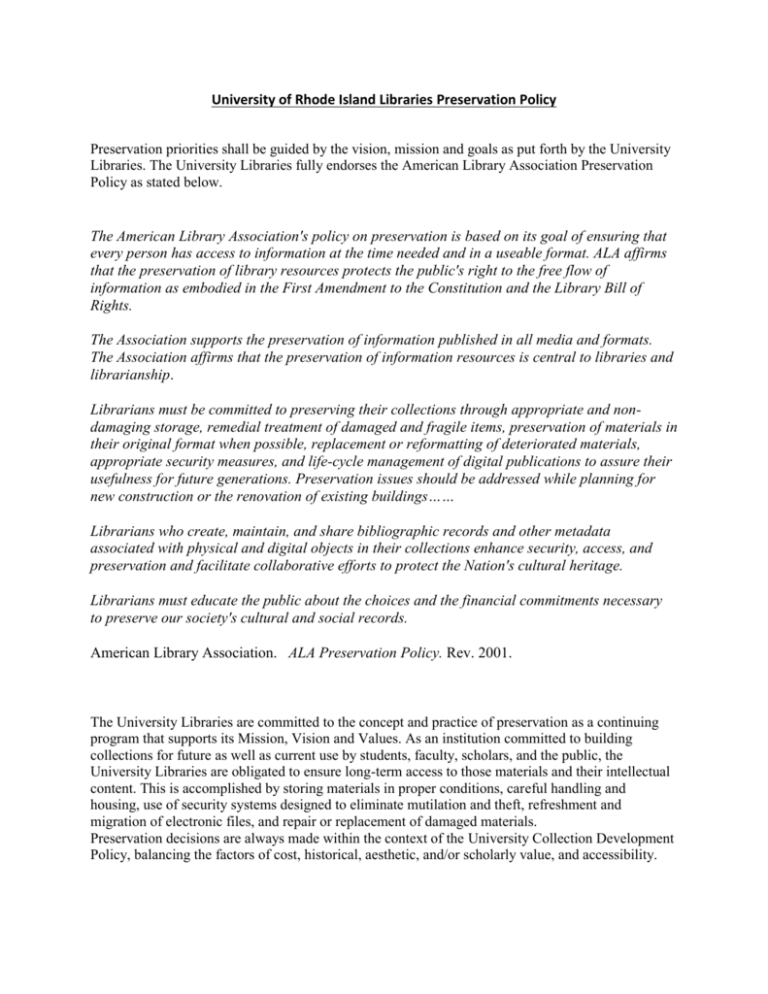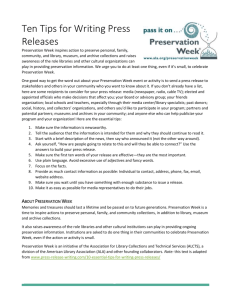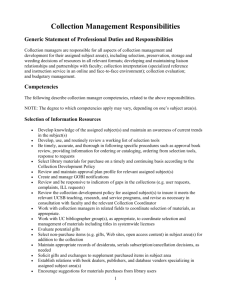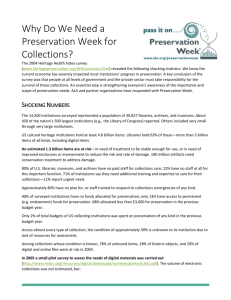University of Rhode Island Libraries Preservation Policy
advertisement

University of Rhode Island Libraries Preservation Policy Preservation priorities shall be guided by the vision, mission and goals as put forth by the University Libraries. The University Libraries fully endorses the American Library Association Preservation Policy as stated below. The American Library Association's policy on preservation is based on its goal of ensuring that every person has access to information at the time needed and in a useable format. ALA affirms that the preservation of library resources protects the public's right to the free flow of information as embodied in the First Amendment to the Constitution and the Library Bill of Rights. The Association supports the preservation of information published in all media and formats. The Association affirms that the preservation of information resources is central to libraries and librarianship. Librarians must be committed to preserving their collections through appropriate and nondamaging storage, remedial treatment of damaged and fragile items, preservation of materials in their original format when possible, replacement or reformatting of deteriorated materials, appropriate security measures, and life-cycle management of digital publications to assure their usefulness for future generations. Preservation issues should be addressed while planning for new construction or the renovation of existing buildings…… Librarians who create, maintain, and share bibliographic records and other metadata associated with physical and digital objects in their collections enhance security, access, and preservation and facilitate collaborative efforts to protect the Nation's cultural heritage. Librarians must educate the public about the choices and the financial commitments necessary to preserve our society's cultural and social records. American Library Association. ALA Preservation Policy. Rev. 2001. The University Libraries are committed to the concept and practice of preservation as a continuing program that supports its Mission, Vision and Values. As an institution committed to building collections for future as well as current use by students, faculty, scholars, and the public, the University Libraries are obligated to ensure long-term access to those materials and their intellectual content. This is accomplished by storing materials in proper conditions, careful handling and housing, use of security systems designed to eliminate mutilation and theft, refreshment and migration of electronic files, and repair or replacement of damaged materials. Preservation decisions are always made within the context of the University Collection Development Policy, balancing the factors of cost, historical, aesthetic, and/or scholarly value, and accessibility. Preservation is a library wide activity, involving all staff. Preservation activities include: training staff and users on proper handling of materials maintaining environmental controls acquiring, processing, storing, and using collections via methods that promote preservation and access providing security (theft prevention) for the collections ensuring long-term access to electronic resources owned by the Libraries repairing, reformatting, or replacing damaged items preventing and managing emergencies that threaten the collection responsible exhibition practices Responsibilities All University Libraries employees share the responsibility for ensuring that both the spirit and intent of this policy are fully implemented throughout the organization. All employees are responsible for the proper care, handling and protection of the collections with which they work. Administration: Ensure the preservation of the collection through the authorization of funding, policies and procedures that provide a framework for the continuing care of library materials. Collection Development: Strive to acquire new holdings in formats that are the most permanent media possible to help ensure their longevity and minimize the cost of preservation. Bibliographers review lost and stolen titles, as well as damaged and irreparable materials, and make recommendations for their replacement or withdrawal from the collection. Special Collections & Archives: Acquire, process, exhibit and store valued materials using resources and methods that promote their long-term preservation. Require readers to use surrogates where the originals are so fragile that using them will cause further damage. Technical Services: Process holdings using materials and methods that promote long-term access to the collections. Ensure that commercial binding services meet national standards and that binding options are properly applied. Provide cataloging services to support the reformatting of damaged holdings. Public Services: Protect the collections from damage and loss through maintenance and implementation of security and emergency procedures, proper shelf maintenance activities, identification and routing of damaged materials for preservation action, and proper packing and shipping of library holdings. Interlibrary Loan practices will be in keeping with guidelines set forth by the American Library Association Responsibilities for Preservation A. Condition Evaluation: assessment of physical condition [Circulation, Interlibrary Loan, Media, CML, Government Publications, Special Collections, Acquisitions/Processing] 1. evaluation of individual volumes to determine appropriate treatment 2. surveys of collections to determine condition and appropriate treatment B. Shelf Preparation: preparation of new material for public use [Cataloging, Government Publications, Acquisitions/Processing] 1. application of appropriate spine labels, identifying marks, etc. to library materials 2. creation/editing of item records for library materials C. Binding: selection of materials in need of commercial binding and/or enclosure [Acquisitions/Processing, Government Publications, Special Collections] 1. 2. 3. 4. 5. evaluation of materials for binding selection of appropriate binding methods and/or type of enclosure management of budget reports and statistic liaison with commercial bindery [external vendor] D. Repair: damaged materials not in need of binding or conservation [Acquisitions/Processing] 1. evaluation of materials for in-house repair 2. selection and execution of appropriate repairs E. Conservation: damaged materials in need of highly specialized treatment [Special Collections] 1. selection and analysis of volumes for treatment by a conservator [external vendor] 2. liaison with conservators [external vendors] 3. management of budget F. Brittle and Deteriorated Books: not suitable for binding or repair [Circulation, Interlibrary Loan, CML, Government Publications, Media, Special Collections, Subject Selectors] 1. 2. 3. 4. identification and analysis of brittle and deteriorated materials bibliographic searching to determine replacement status and microfilming history recommendation of appropriate treatment to subject selectors or others as appropriate execution of appropriate treatment G. Reformatting: transferring intellectual content to another medium [Digital Initiatives, Special Collections, Media] 1. selection of appropriate methods 2. liaison with external vendors 3. management of budget H. Disaster Planning and Response [Disaster Planning Committee, Administration] 1. select and maintain a stock of appropriate supplies 2. coordinate recovery efforts 3. staff education and training I. Environment [Administration, Circulation] 1. monitoring of environmental conditions 2. space planning 3. storage projects J. Information Resources [Collection Development Librarian] 1. selects/recommends appropriate materials on preservation topics K. External Vendors of Preservation Products and Services [Administration, Acquisitions, Collection Development, Public Services, Systems, others as appropriate) 1. develops technical specifications for preservation products and services not available in house 2. participates in the bidding process for external vendors 3. develops standards and inspection procedures for quality control of preservation services 4. maintains records, reports, and statistics on external vendor performance. Sources: American Library Association. ALA Preservation Policy. Rev. 2001 http://www.ala.org/alcts/resources/preserv/01alaprespolicy University Libraries, University at Albany, State University of New York. University Libraries Preservation Policy, 2010. http://library.albany.edu/preservation/PreservationPolicy_RevMar2010.pdf UCB Libraries, University of Colorado, Boulder. Preservation Policy: Principal Functions and Responsibilities, 1996. http://ucblibraries.colorado.edu/adminservices/manual/technical/PreservationPolicy.htm Policy # 12-03 Approved: 6/7/12 Dean Maslyn






